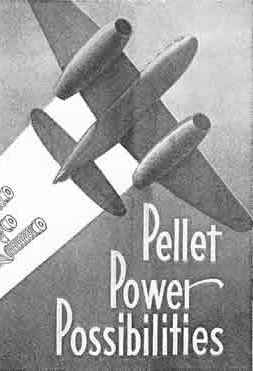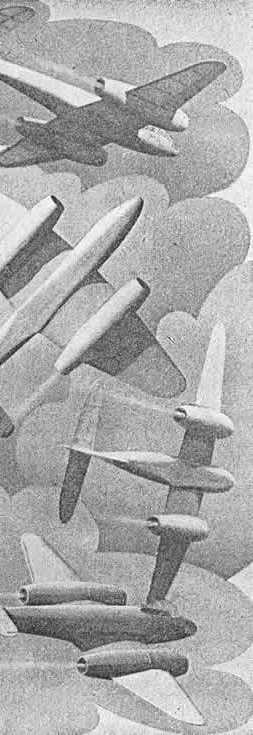 |
 |
 |
 |
 |
|
Editorial – Pellet Power Possibilities
Reprinted from Aeromodeller, June 1948, pp. 24, 44, 94
This is the historic editorial in which Aeromodeller greeted the arrival of the Jetex 100 and 200
motors, and introduced the first published plans – a scale Gloster Meteor and a duration flyer,
Zephyr.
|
|
 In our previous Editorial we referred to a new development in the powering of model aircraft. In this
issue we are able to reveal that this work has been pioneered by Messrs. Wilmot Mansour Ltd., and our
advertisement pages carry the first announcement of the power units which are now available.
Considerable research work has been carried out by the AEROMODELLER technical staff in conjunction
with Wilmot Mansour Ltd., with a view to producing model aircraft suitable for use with these new units,
and in this issue we publish plans of two models in which they may be used. The
first—"Zephyr"—designed by Mr. H. E. (Tim) Hervey, will appeal to beginners and may be
relied upon to give a first class performance. For those aeromodellers who prefer a more advanced
type the "Meteor" should have a special appeal. As the thrust developed by the twin motors in this
model approaches the all-up-weight, a "meteoric" performance may be expected--but care must be taken
to see that both units are working properly before the model is released.
In our previous Editorial we referred to a new development in the powering of model aircraft. In this
issue we are able to reveal that this work has been pioneered by Messrs. Wilmot Mansour Ltd., and our
advertisement pages carry the first announcement of the power units which are now available.
Considerable research work has been carried out by the AEROMODELLER technical staff in conjunction
with Wilmot Mansour Ltd., with a view to producing model aircraft suitable for use with these new units,
and in this issue we publish plans of two models in which they may be used. The
first—"Zephyr"—designed by Mr. H. E. (Tim) Hervey, will appeal to beginners and may be
relied upon to give a first class performance. For those aeromodellers who prefer a more advanced
type the "Meteor" should have a special appeal. As the thrust developed by the twin motors in this
model approaches the all-up-weight, a "meteoric" performance may be expected--but care must be taken
to see that both units are working properly before the model is released.
The past few years have produced such an advance in fullsize jet propulsion that already there are many
who see the future of the airscrew as little more than an obsolete motive power analogous to the horse.
Jet motors for model aircraft have rather lagged behind. The true impulse duct motor as developed in
the States is heavy, noisy, dangerous and, even more important, virtually unobtainable in this country.
Rocket motors have been tried to take the place of jets in scale models, but have proved uncertain in
operation, irregular in thrust, and even dangerously explosive. We welcome therefore a new motor just
released that, while by no means a true "jet" motor, is nevertheless jetlike in operation, and overcomes
most of the defects of alternatives available,
|



-
Aeromodeller, January 1948, p. 355
|
 The basic principle of the new motor is the employment of a solid fuel that is non-explosive in operation. Fuse-induced combustion causes it to generate a gas at the rate of something like 4,000 feet per second, and the discharge of this gas through a jet orifice gives forward motion. A similar fuel in cartridge form was used to operate starters on full size aircraft during the war.
The basic principle of the new motor is the employment of a solid fuel that is non-explosive in operation. Fuse-induced combustion causes it to generate a gas at the rate of something like 4,000 feet per second, and the discharge of this gas through a jet orifice gives forward motion. A similar fuel in cartridge form was used to operate starters on full size aircraft during the war.
The power pellet as made up for model use is particularly interesting, as the manufacturers are able
to guarantee precise weight, constant thrust, and regular duration. Should the duration be overlong
for test purposes the user can cut it in half and enjoy two power flights each of half the normal
duration. In appearance they look somewhat like yellow candles without wicks. The fuses used to ignite
them are separate and added before use.
Aluminium alloy motors to contain the power pellets can be obtained cheaply, and have one advantage
over most motors, in that they are virtually indestructible. As will be seen from the cutaway drawing,
the pellet is loaded by removing the jet nozzle, easing up the spring clips with the special loader
provided. Incidentally a strong pair of fingers will do the job, but with the loader it is less like
hard work. After inserting the pellet, the fuse is coiled up leaving just enough to project about 1/8 of an inch through the jet orifice. The coil should be pressed well down on the surface of the pellet to give maximum burning area using the circle of wire gauze provided. Take care not to strip the fuse material from the wire core when fitting or the charge may not ignite. In addition to holding on the nozzle the springs are designed to lift and allow excess gas to escape at the sides should the thrust for any reason exceed that intended.
Convenient brackets for attachment to models are available and render loading and recharging to be
effected in a few moments. At present two sizes of motor are ready—the Jetex 100, weighing
with charge ¾ oz. giving a thrust of up to 1¼ ozs. and power run of 15 seconds, and the Jetex 200,
weight 1¼ ozs. thrust 2 ozs. duration 30 seconds. A larger model weighing 4 ozs. and having a
4 oz. thrust will be offered in a week or two.
When used in scale models—for which they seem particularly suitable—it should be noted that
the nozzle must not be blanked off, but a cone of at least 100 left for the gas to escape. There is no
doubt that these units offer unlimited scope to the model designer. Jet aircraft can now be faithfully
modelled by the scale enthusiast, witness the Meteor developed by our staff experts and duration fans
have a power unit at their disposal of amazing versatility. Plans of the Meteor and a duration model
suitable for beginners are given on following pages and may well serve as test beds for our more
inventive readers to develop still further.
|



-
Aeromodeller, January 1948, p. 355
|
 |
 |